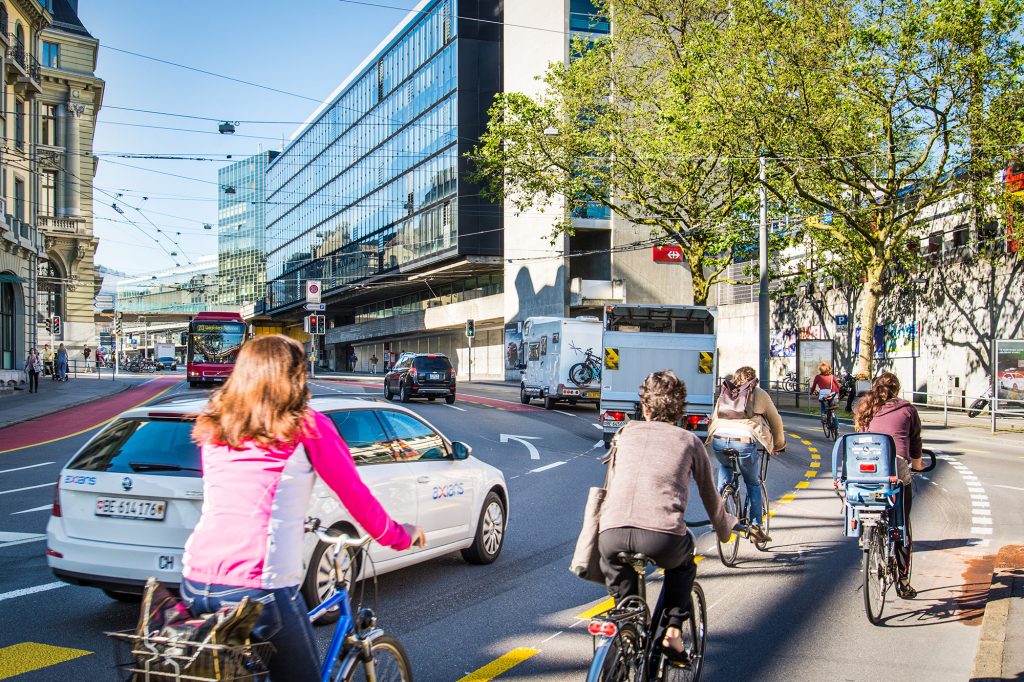In 2014 Bern launched a ‘Velo Offensive’ to make cycling the triumphing transport choice. We asked those involved about which tactics were deployed and whether it can be heralded as a win for the bike.
What Is the Velo Offensive?
Momentum is building to make Bern the cycling capital of Switzerland. Under the banner of “Velo Offensive”, city electorate Ursula Wyss has been heading the attack. “The name expresses what the project aims to achieve”, she explains, “that cycling infrastructure and services in Bern are to be improved quickly and comprehensively.”
Bern, however, is no enemy to the bicycle. “There has long been a bike culture in Bern,” notes Dominik Guggisberg, Director at Pro Velo Bern’s “but this has been based on subcultures: racing cyclists, mountain bikers, bicycle travellers, etc… Everyday bike culture is only just emerging.”
It was this everyday bike culture that Wyss sought to tackle. “Our aim is to make cycling normal in everybody’s everyday life,” she states. “Public space increasingly becomes an ‘urban living room’, where people meet and children can play.”
The first move was to reform Bern’s administrative departments to create a cycle-centric outlook. Despite push back, Wyss held her line and increased both personnel and budget, and forged a cross-departmental working group.
With a strong alliance behind her, the Velo Infrastructure Masterplan commenced. The strategy included 11 cycling routes connecting the outskirts to the city centre, over 1000 bike parking spots, bike rental schemes, and expanding previous cycle-friendly measures. The first track, from Wankdorf to the centre, was accomplished in 2016 and set a high bar due to its width, greenness, and timed traffic lights.

Communication campaigns were also trumpeted. “We used the quote ‘Cycling is Obvious’” explains Wyss, “people already know that cycling is healthy and good for the environment.” The focus was therefore on making Bern more attractive, with an emphasis on cycling being accessible for 8-to-80 year-olds.
So far, the Velo Offensive can claim a victory. Bern was labelled as a ‘prime example of how well-planned infrastructure can increase the number of bicycle users’ Copenhagenize, and a 35 percent increase in bicycle traffic was recorded between 2014 – 2017. Having already increased the modal share of cycling from 11 to 15 percent, Bern is marching towards its target of 20 percent by 2030. “I am convinced that the potential is even higher than our initial goal,” remarks Wyss.
The Key Components to the Velo Offensive’s Victory
Given the success of the Velo Offensive so far, a few key components can be identified as crucial to its triumph.
1. Political Will
Unsurprising, Wyss’s dedication to the Offensive has been a driving force. “She was very important,” notes Michael Sutter, the President of Pro Velo Bern, “she pushed cycling issues in the government and administration and reached out to the public.”
As Julian Baker, a cycling expert at KontextPlan in Bern told us, “she had to overcome opposition within the administration and politically, but she persevered.”
Most of her opponents contested the distribution of land and loss of space for motorists. Her response to any siege, however, was solid and steadfast. “In the past, cars were the dominant mode of transport. This no longer meets the needs of the citizens of Bern,” she states. “There is no such thing as ‘we have no space for a bicycle infrastructure’. It’s just a matter of changing the paradigm and reallocating the existing space.”

2. Public Support
Wyss could not have advanced as far as she did without the public rallying behind her. It was the electorate mandate to implement cycling infrastructure that spurred the offensive on. “There was a lot of public support,” says Julian, “the ideas were in place – she just had to deliver on her promises.”
Michael also notes how the “increased environmental awareness and the better anchoring of the bicycle among younger people” revitalised public support and kept the momentum up.
3. Administrative Reform
By reforming the administrative bodies, it spearheaded more proactive, cycling-centric change. “The collective and coordinated approach of the city administration is certainly a success factor of the ‘Velo Offensive’”, explains Wyss, “Only with sufficient human resources and know-how it is possible to improve the bicycle infrastructure at all levels.”
Dominik Guggisberg from Pro Velo Bern also recognises the force that reform had. “In the administration, people care about the concerns of cyclists who want to move forward,” he says, “the atmosphere is more bike-friendly.”
4. Public Participation
The Velo Offensive dedicated significant funds towards participatory events. Political parties, neighbourhood organisations, businesses, and transport representatives were all consulted. ‘Lunchworkshops’ allowed for residents to discuss issues, surveys and trials were held and children helped design the 20km/h zones in front of their residential areas.
It was lastly this emphasis on hearing the voices of Bern’s citizens throughout the process that has contributed to its cycling culture, ultimately enabling the Offensive to gain ground.
In a Nutshell…
Driven by strong political will, public support, administrative reform, and broad participation, the Velo Offensive achieved its mission. As the battle draws to a close, beautiful Bern is opening up to bicycles – for both 8-to-80-year-old riders – and is becoming a much more liveable urban living room.




